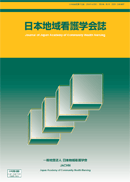Volume 23, Issue 1
Displaying 1-8 of 8 articles from this issue
- |<
- <
- 1
- >
- >|
Original Articles
-
2020Volume 23Issue 1 Pages 4-12
Published: 2020
Released on J-STAGE: April 28, 2020
Download PDF (1276K) -
2020Volume 23Issue 1 Pages 13-22
Published: 2020
Released on J-STAGE: April 28, 2020
Download PDF (1282K)
Research Reports
-
2020Volume 23Issue 1 Pages 23-31
Published: 2020
Released on J-STAGE: April 28, 2020
Download PDF (1263K) -
2020Volume 23Issue 1 Pages 32-41
Published: 2020
Released on J-STAGE: April 28, 2020
Download PDF (1266K) -
2020Volume 23Issue 1 Pages 42-51
Published: 2020
Released on J-STAGE: April 28, 2020
Download PDF (1278K)
Informations
-
2020Volume 23Issue 1 Pages 52-58
Published: 2020
Released on J-STAGE: April 28, 2020
Download PDF (1252K) -
2020Volume 23Issue 1 Pages 59-65
Published: 2020
Released on J-STAGE: April 28, 2020
Download PDF (1259K)
Committee Report
-
2020Volume 23Issue 1 Pages 76-80
Published: 2020
Released on J-STAGE: April 28, 2020
Download PDF (1181K)
- |<
- <
- 1
- >
- >|
